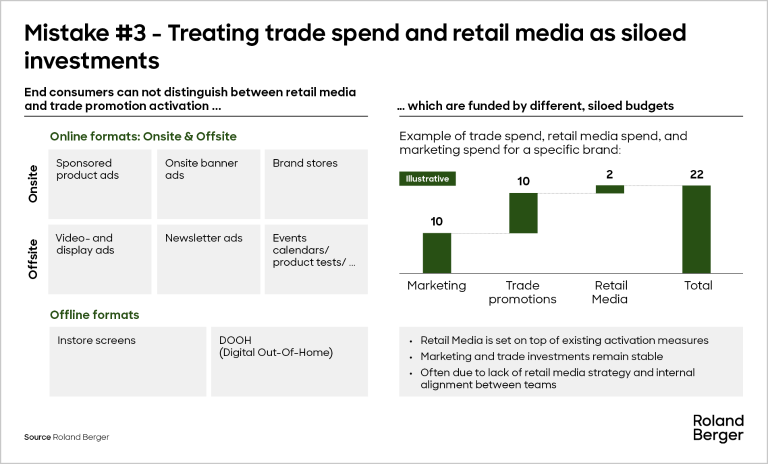The growing trend towards sustainable packaging is more than just a feel-good story—it’s how Consumer Packaged Goods companies can realize future profitability, according to new Roland Berger research.


The 3 biggest trade mistakes that consumer goods companies make
By Robert Baker
Why these common trade mistakes are limiting your company’s growth
_image_caption_none.jpg?v=886461)
Trade is the second biggest line item in the P&L for most consumer goods manufactures and accounts for up to 30% of total revenues, which makes these common mistakes so costly, according to new Roland Berger research.
Introduction: The implications are huge
For most consumer goods companies, trade spending is a big deal. As much as 30% of gross revenue is spent on trade activities, second only to the cost of goods sold. As a significant portion of the overall marketing mix, trade spending is a key lever to drive top-line growth. But make a mistake or get overly complacent, and trade can become a drain on profitable growth.
Many CPG companies struggle to improve the effectiveness of their trade investment for three key reasons: fear of lost sales that might result from changing “Entitlement” retailer programs, comfort with the status quo and shying away from hard conversations with buyers, and limited access to reliable data that people can trust for decision-making. Because of this, many companies are hesitant to make significant changes to their trade funds architecture or spending approach - changes that people know should be made to boost operational performance of the business.
Roland Berger has identified three very common mistakes that consumer goods companies make that limit growth opportunities:
- Trade investment strategy that is out of sync with brand and channel strategies
- An over-reliance on trade spending as a pricing lever
- Treating trade and retail media as siloed investments
The good news is there are proven ways to overcome these mistakes. To get there, however, you need to understand the root causes of the problems.
"Our end-to-end approach to RGM transformation comes from decades of working in the shoes of our clients - this perspective enables Roland Berger to provide our clients with the right set of options…and then cut to the answer, align around the desired outcome and activate with speed and purpose."
The 3 biggest trade mistakes
Despite the magnitude and importance of trade as a top-line growth driver, CPGs often manage it as a cost of doing business, rather than a strategic investment in the business. We see this manifest in several behavioral ways.
First, Key Account Managers habitually replicate year-over-year trade spending as an entitlement for the retailer regardless of the overall performance of that investment. Second, changes in spending often create complicated conversations between retailers and account managers who aren’t properly trained on renegotiations (or are simply in the dark on the latest funding goals). Lastly, KPIs to track trade spending ROI are either unavailable or unreliable, which hinders decision-making, trust in desired outcomes, and creates risk aversion to trying new investment options.
These behaviors create big problems, like reduced profitability and competitiveness, an inability to quickly shift funds to higher ROI opportunities, or overpaying for brand activations at the account level resulting in inflated acquisition costs.
The bad news is that these behaviors are quite common across the industry and contribute to a lower overall growth potential across several segments. The good news is they can be traced to three common mistakes that, if corrected, can quickly swing the trade ROI pendulum in the right direction.
Mistake #1: Trade investments out of sync with brand and/or customer strategies.
For many CPGs, recent consumer trends and economic conditions have created a disconnect between brand strategy and the role of trade. Many factors can cause those misalignments, but the tendency to replicate spending levels year over year, coupled with misaligned incentives between marketing and sales (e.g., growth vs profitability), are often at the top of the list.
_image_caption_none.png?v=886458)
The problem is that these misalignments often lead to overspending on non-strategic brands or channels. In the short term, Roland Berger recommends adjusting trade rates to align with brand and channel strategies. This involves identifying higher than desired trade rates, assessing which brands or channels are overinvested, and modeling a more strategic investment position aligned with brand strategy and future outlet importance.
In the long-term, we recommend a “performance-based” trade funding approach combined with investments in KAM skills training that focus on building strategic retailer relationships and joint business planning. Doing so involves moving from an unconditional spending structure that is based on historical funding models, to a variable structure that ties trade rates to retail activities or outcomes (e.g., dollar sales, new item acceptance). This approach can simultaneously improve trade ROI and retailer collaboration beyond the limits of a simple transactional relationship.
Mistake #2: Over reliance on trade spending as a pricing lever
Many CPGs use trade to cover deficiencies in brand or product pricing and use EDLP as a negotiation tactic for target shelf prices at retail. If EDLP accounts for more than 60-70% of total trade spending, however, a full review of list price structure is likely needed as this is often a sign that your pricing approach does not align with the product’s consumer value proposition.
_image_caption_none.png?v=886462)
Also, many Key Account Managers leverage everyday low pricing (EDLP) versus promotional spending to protect trade funding in leaner times. Put simply, EDLP is often considered non-discretionary spend because it is hard to unwind once in place, and difficult to measure for ROI versus traditional promotional spend.
Regardless, overreliance on trade as a price lever can result in less flexibility to shift funds to higher ROI activities. On top of that, most companies don’t know the ROI of their EDLP spending at all, and are likely in the dark on 50% or more of their total trade investment. To correct this, CPG’s should conduct a data-driven root cause diagnostic which includes several product-level analyses such as price waterfalls and willingness to pay, and customer analyses such as holistic retailer profitability and omnichannel growth potential
Understanding the root cause is essential for developing targeted action plans. For example, inadequate list prices may require a price deal realignment, based upon an updated consumer value proposition.
Mistake #3: Treating trade spend and retail media as siloed investments
Since CPG companies often have different teams managing trade and retail media, decisions are often uncoordinated leading to “stacked spending” at retail. In and of itself, this isn’t a problem so long as you understand the holistic spending across weeks for any given product and customer combination.

Unfortunately, most CPGs have not developed the process and analytics to ensure full spectrum capture across all spend levers at the customer and product intersection. A lack of cross-functional collaboration is also a common challenge, adding further cloudiness in the spending picture from different functions such as e-commerce, sales, and marketing working under quite different objectives or mandates.
In order to solve this issue, Roland Berger recommends intensifying cross functional reporting transparency on spending per brand and retailer budgets, especially for brands with a high combination of trade and retail media spend. All told, CPG’s must ensure that key enablers are in place, including organizational upskilling, leadership buy-in, clear roles and responsibilities, and modernized technology and data architecture to support and simplify the desired approach.
Easier said than done. But there is hope.
Conclusion: Roland Berger can help
Although the above trade spending mistakes are common, they can be overcome. Roland Berger has helped many leading consumer goods companies around the globe modernize their approach to trade funding and retail investment. We do this with a proven approach to diagnosing trade spending inefficiencies while addressing the key enablers for sustainable improvement.
Optimizing the “People,” “Processes,” and “Technology” used is obviously a big factor. Having the right people and ways of working that regularly assess trade data, generate insights, and negotiate changes is key to successful trade management. Moreover, there must be a corporate change in mindset with support and leadership buy-in to focus on constant trade optimization.
As for “Processes,” organizations should formalize and clarify roles and responsibilities for activities related to trade optimization. This means stepping back and ensuring the foundation is in place before turning to “Technology,” such as aTrade Promotion Optimization (TPO) platform, as a way to drive efficiency and standardization in analysis and decision-making.
Wherever you are in the trade spending continuum, Roland Berger can help. With an end to end understanding of all segments within the consumer goods industry, we’ve worked with leading CPG companies on all aspects of sustainable revenue growth, including RGM strategy, pricing, price-pack architecture and flexible performance-based trade funding programs.
If you are interested in learning more about Roland Berger’s approach, accessing the full version of our study, or getting more detailed recommendations, please contact Robert Baker. We welcome the opportunity to discuss your company’s specific trade challenges and ultimately share our experience and informed perspective on the best ways to address them.
We would like to thank Rebeca Dauscha for her contribution to this article.




